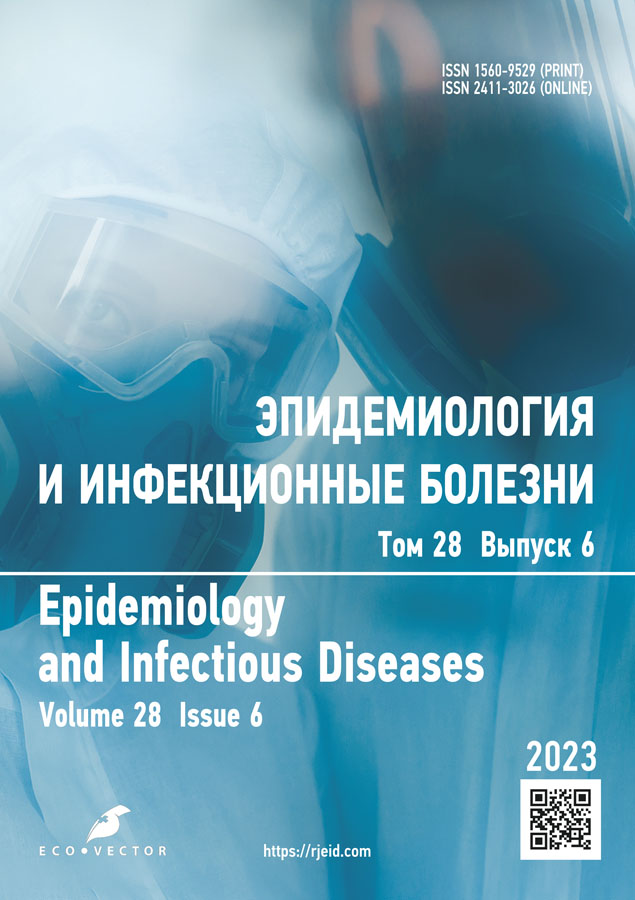Analysis of long-term dynamics of morbidity by the method of complex assessment at different territorial levels
- Authors: Savilov E.D.1,2, Khromova P.A.1, Shugaeva S.N.2,3, Oryshchak S.E.3, Sinkov V.V.1, Ogarkov O.B.1
-
Affiliations:
- Scientific Centre for Family Health and Human Reproduction Problems
- Irkutsk State Medical Academy of Postgraduate Education
- Irkutsk State Medical University
- Issue: Vol 28, No 6 (2023)
- Pages: 353-362
- Section: Original study articles
- Submitted: 19.09.2023
- Accepted: 30.10.2023
- Published: 25.12.2023
- URL: https://rjeid.com/1560-9529/article/view/569175
- DOI: https://doi.org/10.17816/EID569175
- ID: 569175
Cite item
Abstract
BACKGROUND: A comparative epidemiological analysis of the primary incidence of tuberculosis was performed using its standard approach with a generalized indicator that considers the main statistical criteria for incidence. The “sensitivity” of the method may vary depending on the population from analyzed territories.
AIM: This study aimed to perform a comparative assessment of the epidemiology of tuberculosis (TB) in different territories based on the standard incidence rate and modified method of its integral assessment.
MATERIALS AND METHODS: A retrospective study of the dynamics of the incidence of tuberculosis in the total population from the federal districts (FD) of Russia and participants from the Siberian Federal District (SFD) and urban municipalities of the Irkutsk Region (a structural unit of the SFD) between 2005 and 2019 was performed. Based on the obtained integral indicators, a generalized visibility coefficient was calculated.
RESULTS: A significant decrease in the incidence of TB was found in all patients from FD and SFD participants. Assessment of the average long-term incidence rates showed that the maximum discrepancy between ranking places was inversely proportional to the size of the studied territories: 1.5 positions, at the level of the FD; two positions, at the level of regional formations; and five positions, at the level of urban settlements.
CONCLUSIONS: The integral assessment method can be used in the primary analysis of morbidity in all types of infectious and noninfectious pathologies. The generalized morbidity criterion expands the informative possibilities of the standard indicator, contributes to the substantiation of risk areas at the initial stages of epidemiological analysis, and responds more “sensitively” to changes in the epidemiological situation in relatively small areas.
Keywords
Full Text
About the authors
Evgeniy D. Savilov
Scientific Centre for Family Health and Human Reproduction Problems; Irkutsk State Medical Academy of Postgraduate Education
Email: savilov47@gmail.com
ORCID iD: 0000-0002-9217-6876
SPIN-code: 1057-7837
MD, Dr. Sci. (Med.), Professor
Russian Federation, Irkutsk; IrkutskPolina A. Khromova
Scientific Centre for Family Health and Human Reproduction Problems
Author for correspondence.
Email: polina.and38@gmail.com
ORCID iD: 0000-0002-6449-5060
SPIN-code: 1286-3644
Russian Federation, Irkutsk
Svetlana N. Shugaeva
Irkutsk State Medical Academy of Postgraduate Education; Irkutsk State Medical University
Email: shugaeva_s@mail.ru
ORCID iD: 0000-0002-3660-9278
SPIN-code: 7832-3653
MD, Dr. Sci. (Med.), Associate Professor
Russian Federation, Irkutsk; IrkutskSvetlana E. Oryshchak
Irkutsk State Medical University
Email: kisel.swetl@yandex.ru
ORCID iD: 0000-0002-4428-7184
SPIN-code: 5260-3094
MD
Russian Federation, IrkutskVyacheslav V. Sinkov
Scientific Centre for Family Health and Human Reproduction Problems
Email: vsinkov@yandex.ru
ORCID iD: 0000-0003-3396-9590
SPIN-code: 7280-3026
MD, Cand. Sci. (Med.)
Russian Federation, IrkutskOleg B. Ogarkov
Scientific Centre for Family Health and Human Reproduction Problems
Email: obogarkov@mail.ru
ORCID iD: 0000-0002-3168-1983
SPIN-code: 1956-2888
MD, Dr. Sci. (Med.)
Russian Federation, IrkutskReferences
- Sazykin VL, Son IM. Comprehensive assessment of the tuberculosis epidemic situation in Russia. Problemy tuberkuleza i boleznei legkikh. 2006;83(10):65–69. (In Russ).
- Bardymova EV, Khantaeva NS. The role of medical-organizational factors in the development of the epidemiological situation of tuberculosis in the Irkutsk region for the period of 2000–2010. The Transbaikalian Medical Bulletin. 2012;(1):86–93. (In Russ).
- Zhakipbaeva BT, et al. Comprehensive assessment of the epidemiological situation of tuberculosis and analysis of anti-tuberculosis work in Kazakhstan. Gigiena, epidemiologiya i immunobiologiya. 2009;39(1):90–96. (In Russ).
- Poddubny AV. Analysis of epidemiological situation concerning drug addiction in Sverdlovsk region. Ural Medical Journal. 2016;139(6):97–102. (In Russ).
- Nechaeva OB. TB situation in Russia. Tuberculosis and Lung Diseases. 2018;96(8):15–24. (In Russ). doi: https://doi.org/10.21292/2075-1230-2018-96-8-15-24
- Global tuberculosis report 2022. Geneva: World Health Organization; 2022. 68 p.
- Savilov ED, Kolesnikov SI, Anganova EV, Astafev VA. The summary assessment of the prevalence rate morbidity on main statistical indices. Hygiene and Sanitation. 2018;97(3):274–278. (In Russ).
- Khromova PA, Sinkov VV, Savilov ED, Ogarkov OB. Complex analysis of the epidemiological situation of tuberculosis used as an additional tool for determining the “risk areas” on the Siberian Federal District. Epidemiology and Vaccinal Prevention. 2021; 20(3):37–44. (In Russ). doi: 10.31631/2073-3046-2021-20-3-37-44
- Savilov ED, Astafiev VA, Zhdanova SN, Zarudnev EA. Epidemiologicheskii analiz: Metody statisticheskoi obrabotki materiala. Novosibirsk: Science Center; 2011. 156 p. (In Russ).
Supplementary files








